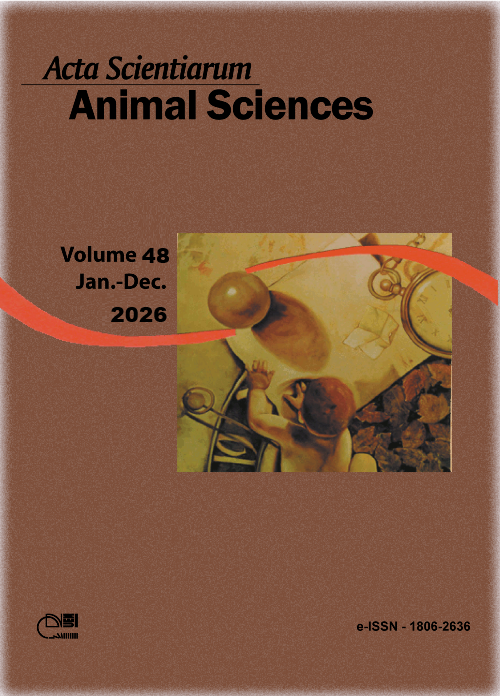Performance comparison of broiler chickens reared in closed versus stage slatted-floor open-sided houses: a case study of broiler farmers under an inti-plasma partnership model in Indonesia
Resumo
Over the last few decades, the Indonesian government has designed a partnership model for the farming system called an inti-plasma model. An inti or a core was a large private company, while the plasmas were smallholders that collaborated with the core. In the subsector of animal husbandry, the animal housing system has been considered the main regulation to achieve a contract between the core and plasmas. This study aimed to evaluate the performance comparison of broiler chickens kept in the closed house (CH) versus those kept in the stage slatted-floor open-sided house (OH) at broiler farms in Desa Simpang Jambe, Indonesia, in partnership with Charoen Pokphan Jaya Farm. This study was conducted in a completely randomized design (CRD) with two treatments and ten replications. The treatments were broilers reared in CH, and those in the OH. Each replication was an experimental unit with 4,800 birds pen-1 in the CH and 600 birds pen-1 in the OH. Twenty birds were randomly sampled from each pen for body weight (BW) and feed intake (FI), resulting in 200 sampling birds from each house. Data were analyzed using a t-test analysis. The results of this study showed that during the starter period, BW, body weight gain, feed intake, mortality, and depletion were significantly better at p < 0.05 and p < 0.01 in the OH than in the CH, but feed conversion ratio was not significantly different at p > 0.05 between both houses. However, during the grower/finisher and overall periods, all performance parameters were significantly different (p < 0.01) by house type. In conclusion, producing broilers at 4 or 5 weeks of marketed ages in the closed house performed better performance index than those in the stage slatted-floor open-sided house.
Downloads
Referências
Abdollahi, M. R., Zaefarian, F., & Ravindran, V. (2018). Feed intake response of broilers: Impact of feed processing. Animal Feed Science and Technology, 237, 154-165. https://doi.org/10.1016/j.anifeedsci.2018.01.013
Abudabos, A. M., Samara, E. M., Hussein, E. O. S., Al-Ghadi, M. Q., & Al-Etiyat, R. M. (2013). Impacts of stocking density on the performance and welfare of broiler chickens. Italian Journal of Animal Science, 12(11), 66-71. https://doi.org/10.4081/ijas.2013.e11
Abu-Dieyeh, Z. H. M. (2006). Effect of chronic heat stress and long-term feed restriction on broiler performance. International Journal of Poultry Science, 5(2), 185-190. https://doi.org/10.3923/ijps.2006.185.190
Aerts, J. M., Lippens, M., De Groote, G., Buyse, J., Decuypere, E., Vranken, E.,& Berckmans, D. (2003). Recursive prediction of broiler growth response tofeed intake by using a time-variant parameter estimation method. Poultry Science, 82(1), 40-49. https://doi.org/10.1093/ps/82.1.40
Apalowo, O. O., Ekunseitan, D. A., & Fasina, Y. O. (2024). Impact of heat stress on broiler chicken production. Poultry, 3(2), 107-128.https://doi.org/10.3390/poultry3020010
Cassuce, D. C.,Tinôco, I. D. F. F., Baêta, F. C., Zolnier, S., Cecon, P. R., &Vieira, M. D. F. A. (2013). Thermal comfort temperature update for broiler chickens up to 21 days of age. Engenharia Agrícola, 33(1), 28-36. https://doi.org/10.1590/S0100-69162013000100004
Elgaber, A. A., Mohammed, A. A. A., Mahmoud, U. T., & Darwish, M. H. A. (2023). Effect of stocking density on broilers behaviour and welfare indices. Assiut Veterinary Medical Journal, 69(179), 1-13. https://doi.org/10.21608/avmj.2023.186702.1122
Farida, T. E., Hanafi, N. D., & Tafsin, M. (2022). Comparative study of broiler chicken performance in closed house and conventional system in North Sumatera.IOP Conference Series: Earth and Environmental Science, 977, 012138. https://doi.org/10.1088/1755-1315/977/1/012138
Hamiyanti, A. A., Nurgiartiningsih, V. M. A., Muharlien, M., & Suyadi, S. (2023).Open, semi-closed, and closed house systems during rainy season. In E. Widodo, V. D. Ton, R. Tian, N. Man, & M Mashudi (Eds.), Proceedings of the 3rd International Conference on Environmentally Sustainable Animal Industry (Advances in Biological Sciences Research Volume 28, pp. 411-419). Atlantis Press.
Laili, A. R., Damayanti, R., Setiawan, B., & Hidanah, S. (2022). Comparison of broiler performance in closed house and open house systems in Trenggalek. Journal of AppliedVeterinary Science and Technology, 3(1), 86-91. https://doi.org/10.20473/javest.V3.I1.2022.6-11
Muharlien, M., Sudjarwo, E., Yulianti, D. L., Hamiyanti, A. A., & Prayogi, H. S. (2022). Comparative production performance of broiler under opened house and closed house system. Jurnal Ilmu-ilmu Peternakan, 30(1), 86-91. https://doi.org/10.21776/ub.jiip.2020.030.01.09
Nawaz, A. H., Amoah, K., Leng, Q. Y., Zheng, J. H., Zhang, W. L., & Zhang, L. (2021). Poultry response to heat stress: its physiological, metabolic, and genetic implications on meat production and quality including strategies to improve broiler production in a warming world. Frontiers in Veterinary Science, 8, 699081. DOI: https://doi.org/10.3389/fvets.2021.699081.
Nuryati, T. (2019). Analisis performans ayam broiler pada kandang tertutup dan kandang terbuka. Jurnal Peternakan Nusantara, 5(2), 77-86. https://doi.org/10.30997/jpnu.v5i2
Orheruata, A. M., Vaikosen, S. E., Alufohia, G., & Okagbare, G. O. (2006). Modeling growth response of broiler chicken to feed consumption using linear data based model structure. International Journal of Poultry Science, 5(5), 453-456. https://doi.org/10.3923/ijps.2006.453.456
Ott, R. L. (1991). An introduction to statistical methods and data analysis. Duxbury Press.
Pakage, S., Hartono, B., Fanani, Z.,Nugroho, B. A., Iyai, D. A., Pulungan., J.A., Ollong, A. R., & Nurhayati, D. (2020). Pengukuran performa produksi ayam pedaging pada closed house system dan open house system di Kabupaten Malang Jawa Timur Indonesia. Jurnal Sain Peternakan Indonesia, 15(4), 383-389. https://doi.org/10.31186/jspi.id.15.4.383-389
Direktorat Pengolahan dan Pemasaran Hasil Peternakan. (2017). Buku saku panduan kemitraan usaha peternakan. Direktorat Jenderal Peternakan dan Kesehatan Hewan.
Santoso, H., & Sudaryani, T. (2009). Pembesaran ayam pedaging di kandang panggung. Penebar Swadaya Press.
Sumarno, Y. W., &Supartini, N. (2022). Study of broiler production performance in closed house and open house cage systems. Jurnal Agriekstensia, 21(1), 42-50.
Vale, M. M., Moura, D. J., Nääs, I. A., & Pereira, D. F. (2010). Characterization of heat waves affecting mortality rates of broilers between 29 days and market age. Brazilian Journal of Poultry Science, 12(4), 279-285.
Yassin, H., Velthuis, A. G. J., Boerjan, M., & van Riel, J. (2009). Field study on broilers’ first-week mortality. Poultry Science, 88(4), 798-804. https://doi.org/10.3382/ps.2008-00292
Yerpes, M., Llonch, P., & Manteca, X. (2020). Factors associated with cumulative first-week mortality in broiler chicks. Animals, 10(2), 310.https://doi.org/10.3390/ani10020310
Copyright (c) 2026 Zulfan Zulfan, Muhammad Daud, Fizalul Ikram

This work is licensed under a Creative Commons Attribution 4.0 International License.
DECLARAÇÃO DE ORIGINALIDADE E DIREITOS AUTORAIS
Declaro que o presente artigo é original, não tendo sido submetido à publicação em qualquer outro periódico nacional ou internacional, quer seja em parte ou em sua totalidade.
Os direitos autorais pertencem exclusivamente aos autores. Os direitos de licenciamento utilizados pelo periódico é a licença Creative Commons Attribution 4.0 (CC BY 4.0): são permitidos o compartilhamento (cópia e distribuição do material em qualqer meio ou formato) e adaptação (remix, transformação e criação de material a partir do conteúdo assim licenciado para quaisquer fins, inclusive comerciais.
Recomenda-se a leitura desse link para maiores informações sobre o tema: fornecimento de créditos e referências de forma correta, entre outros detalhes cruciais para uso adequado do material licenciado.








































